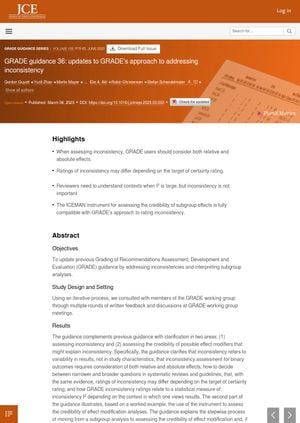Grade Guidance 36: Updates to GRADE's Approach to Addressing Inconsistency
March 2023
in “
Journal of Clinical Epidemiology
”

TLDR The updated GRADE guidance advises considering context when interpreting variability in research results and introduces tools for assessing subgroup effects.
The updated Grading of Recommendations Assessment, Development and Evaluation (GRADE) guidance addresses inconsistencies in systematic reviews and meta-analyses. It clarifies that inconsistency refers to variability in results, not study characteristics, and emphasizes the need to consider both relative and absolute effects when assessing inconsistency for binary outcomes. The guidance introduces the ICEMAN instrument for assessing the credibility of subgroup effects, which is fully compatible with GRADE's approach. It also explains the process of moving from a subgroup analysis to assessing the credibility of effect modification. The document highlights the importance of understanding the contexts when I2 (a statistical measure of inconsistency) is large but inconsistency is not important. It also discusses the importance of addressing heterogeneity in effects, and how GRADE suggests summarizing these differences in separate summary of findings tables. The document concludes that overreliance on I2 could mislead and that the interpretation of I2 must consider the context.
